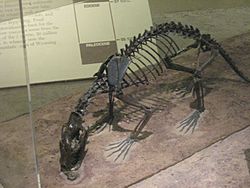Hyaenodont facts for kids
Quick facts for kids Hyaenodontidae |
|
|---|---|
 |
|
| Hyaenodon gigas and H. mongoliensis | |
| Scientific classification | |
| Kingdom: | |
| Phylum: | |
| Class: | |
| Order: | |
| Family: |
Hyaenodontidae
Leidy, 1869
|
The Hyaenodontidae were a group of ancient mammals. Their name means "hyaena teeth." They are now extinct, meaning they no longer live on Earth.
Hyaenodonts belonged to an order called Creodonta. This group included many different types of meat-eating mammals. Scientists have found fossils of many different kinds of hyaenodonts.
These animals were important mammalian predators. They first appeared during the late Paleocene epoch. This was a very long time ago, after the dinosaurs died out. They continued to live and hunt until the late Miocene epoch. Hyaenodonts were found all over the world. They were more common and successful than a related group called oxyaenids.
What Hyaenodonts Looked Like
Hyaenodonts had long skulls and thin jaws. Their bodies were slender, and they walked on their toes. This is different from how humans walk, which is flat-footed. Their size varied a lot. Some were quite small, like a medium-sized dog. Others were very large.
The biggest species was called Hyaenodon gigas. It could be as tall as 1.4 meters (about 4.5 feet) at the shoulder. It could also be 3 meters (about 10 feet) long. This huge animal weighed around 500 kilograms (about 1,100 pounds). But most hyaenodonts were much smaller. They usually weighed between 5 and 15 kilograms.
Fossils of their skulls show they had a very good sense of smell. This helped them find prey. Their teeth were special. They were designed for cutting and slicing meat.
Their Teeth
Hyaenodonts had teeth that were great for shearing meat. However, they were not good at crushing bones. This is a big difference from modern hyaenas. Modern hyaenas have very strong jaws and teeth. They can crush the bones of large prey. This helps them get calcium and nutritious bone marrow.
Modern bears and dogs can also crush bones. But they cannot do it as well as hyaenas. Because hyaenodonts could not crush bones, they could only eat meat. They could not get nutrients from bones. This meant their diet was less varied.
In hyaenodonts, certain teeth were used for cutting. These are called carnassials. They were usually the second upper and third lower molars. Some hyaenodonts even had up to three pairs of these special cutting teeth.
How Hyaenodonts Lived
Because hyaenodonts came in many different sizes, they likely hunted in different ways. This allowed them to fill many different roles in their ecosystems.
Smaller hyaenodonts might have hunted in groups. They could have hunted at night, similar to how wolves do today. Larger and fiercer hyaenodonts probably hunted alone. They would use their large size and powerful jaws to catch prey. They might have hunted during the daytime.
See also
 In Spanish: Hyaenodontidae para niños
In Spanish: Hyaenodontidae para niños


